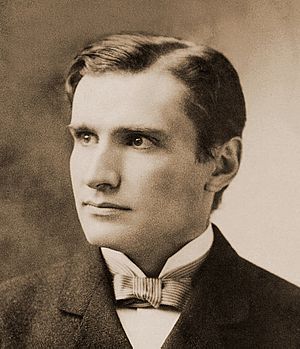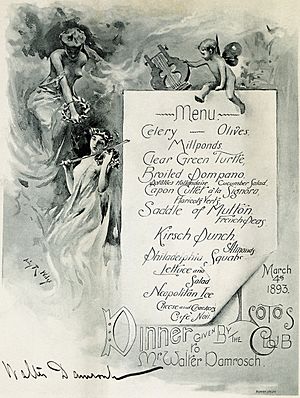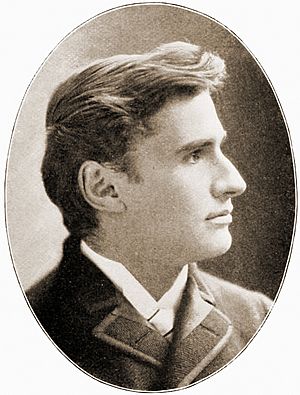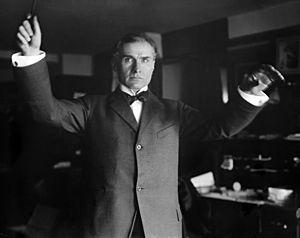Walter Damrosch facts for kids
Quick facts for kids
Walter Damrosch
|
|
|---|---|

Walter Damrosch at age 27
|
|
| Born |
Walter Johannes Damrosch
January 30, 1862 |
| Died | December 22, 1950 (aged 88) |
| Burial place | Ledgelawn Cemetery, Bar Harbor, Maine |
| Occupation | Conductor, composer |
| Years active | 1881–1950 |
| Signature | |
Walter Johannes Damrosch (January 30, 1862 – December 22, 1950) was an American conductor and composer. He was born in Prussia, which is now part of Germany. Walter Damrosch led the New York Symphony Orchestra for many years.
He conducted the very first performances of several famous musical pieces. These included Aaron Copland's Symphony for Organ and Orchestra and George Gershwin's Piano Concerto in F and An American in Paris. He also conducted Jean Sibelius' Tapiola and Sergei Rachmaninoff's Piano Concerto No. 3. Rachmaninoff himself was the piano soloist for that performance. Walter Damrosch also played a big part in creating Carnegie Hall, a famous music venue in New York City.
Contents
His Life and Musical Journey
Walter Damrosch was born in Breslau, a city in Silesia. His mother, Helene von Heimburg, used to be an opera singer. His father, Leopold Damrosch, was also a conductor. Walter had two siblings who also loved music: his brother Frank Damrosch was a conductor, and his sister Clara Mannes was a music teacher.
Walter showed an interest in music from a young age. His father taught him about harmony. He also studied music at the Dresden Conservatory. In 1871, when Walter was nine years old, his family moved to the United States.
In May 1881, his father held a big music festival. Walter, who was only 19, helped by leading parts of the large choir. He led groups in New York City and Newark, New Jersey. The group in Newark chose him as their conductor. He led concerts that featured important works like Anton Rubinstein's Tower of Babel and Giuseppe Verdi's Requiem. Even at a young age, he was very good at leading large groups of musicians.
In 1884, Walter's father started a series of German operas at the Metropolitan Opera in New York. Walter became an assistant conductor there. After his father passed away in 1885, Walter continued in the same role. He also became the conductor for the Oratorio and Symphony Societies in New York.
On May 17, 1890, Walter married Margaret Blaine. She was the daughter of James G. Blaine, a well-known American politician. Walter and Margaret had four daughters: Alice, Margaret (called Gretchen), Leopoldine, and Anita. In 1946, his daughter Margaret Gretchen wrote a book called From the Top of the Stairs. It was about her childhood growing up with music and meeting many famous people.
Damrosch was very famous for conducting the music of Richard Wagner. In 1894, he started the Damrosch Opera Company to perform Wagner's operas. He was also one of the first people to perform classical music on the radio. This helped many Americans learn about and enjoy classical music. From 1908 to 1911, he worked with the famous harp player Vincent Fanelli. In 1918, he helped reorganize the bands for the American army during World War I.
One of his biggest achievements was conducting the first performance of Wagner's Parsifal in the United States. This difficult opera was performed in March 1886. In 1886, he was invited to Germany to conduct some of his father's music. He also led the first U.S. performance of Carl Goldmark's opera Merlin in 1887.
Before he became famous for his radio shows, Damrosch was also known as a composer and teacher. He wrote operas based on stories like The Scarlet Letter (1896), Cyrano (1913), and The Man Without a Country (1937). These operas are not performed very often today. He also wrote music for plays like Medea and Electra. He composed songs too, like the dramatic Danny Deever.
Walter Damrosch was the music director for the National Broadcasting Company. From 1928 to 1942, he hosted a popular radio show called Music Appreciation Hour. This show taught students about classical music. It was broadcast during school hours, and teachers received textbooks and worksheets. Some critics felt that Damrosch made up silly lyrics for the music to "help" young people understand it. For example, for Franz Schubert's Unfinished Symphony, he used the lyric:
- This is the symphony,
- That Schubert wrote and never finished.
Even though he was interested in new music technologies, Damrosch did not make many recordings. His first recording was in 1903, the prelude to Bizet's Carmen. He recorded very few long musical pieces. One of the only symphonies he recorded was Brahms's Second Symphony. He also recorded music by Maurice Ravel, Camille Saint-Saëns, Christoph Willibald Gluck, and others.
Walter Damrosch passed away in New York City in 1950. He is buried in Ledgelawn Cemetery in Bar Harbor, Maine.
In 1939, Damrosch was chosen to be part of the American Philosophical Society. Damrosch Park at Lincoln Center in New York City is named after his family. A public school in the Bronx, P186X Walter J. Damrosch School, is also named after him.
Bringing French Musicians to America
In April 1905, Walter Damrosch traveled to France and Belgium. He was looking for talented musicians for the New York Symphony Orchestra, which he led for many years. He hired five excellent musicians: oboist Marcel Tabuteau, flutist Georges Barrère, bassoonist Auguste Mesnard, and clarinetist Leon Leroy from France. He also hired trumpeter Adolphe Dubois from Belgium.
Damrosch was fined by the musicians' union because he did not advertise for musicians from New York. However, the musicians he brought from Europe were allowed to stay. These five musicians greatly improved the quality of the New York Symphony Orchestra.
Marcel Tabuteau was especially important. He became the main oboe player for the Philadelphia Orchestra from 1915 to 1954. He also taught at the Curtis Institute of Music in Philadelphia. His teaching had a huge impact on how the oboe was played in the United States. It also raised the level of woodwind playing in general.
Georges Barrère was also well-known. He led his own music groups and was an important teacher. He was the main flute player in the New York Symphony Orchestra for a long time. The other three musicians Damrosch brought were also valuable additions to the music scene in New York.
His Musical Compositions
Walter Damrosch composed several musical works, including operas and songs. Here are some of his notable compositions:
- The Scarlet Letter (1894) - An opera based on the famous book by Nathaniel Hawthorne.
- The Manila Te Deum - A piece for singers and orchestra, written to celebrate Dewey's victory at Manila Bay.
- Three songs
- Sonata for violin and piano
- At Fox Meadow
- Cyrano (1913) - A grand opera based on Rostand's play.
- The Dove of Peace (1912) - A comic opera or musical that he helped compose and write.
- Electra (1918 revival) - Music he wrote for a play.
- My Musical Life (1922) - His own story about his life in music.
- The Man Without a Country (1937)
See also
 In Spanish: Walter Johannes Damrosch para niños
In Spanish: Walter Johannes Damrosch para niños




